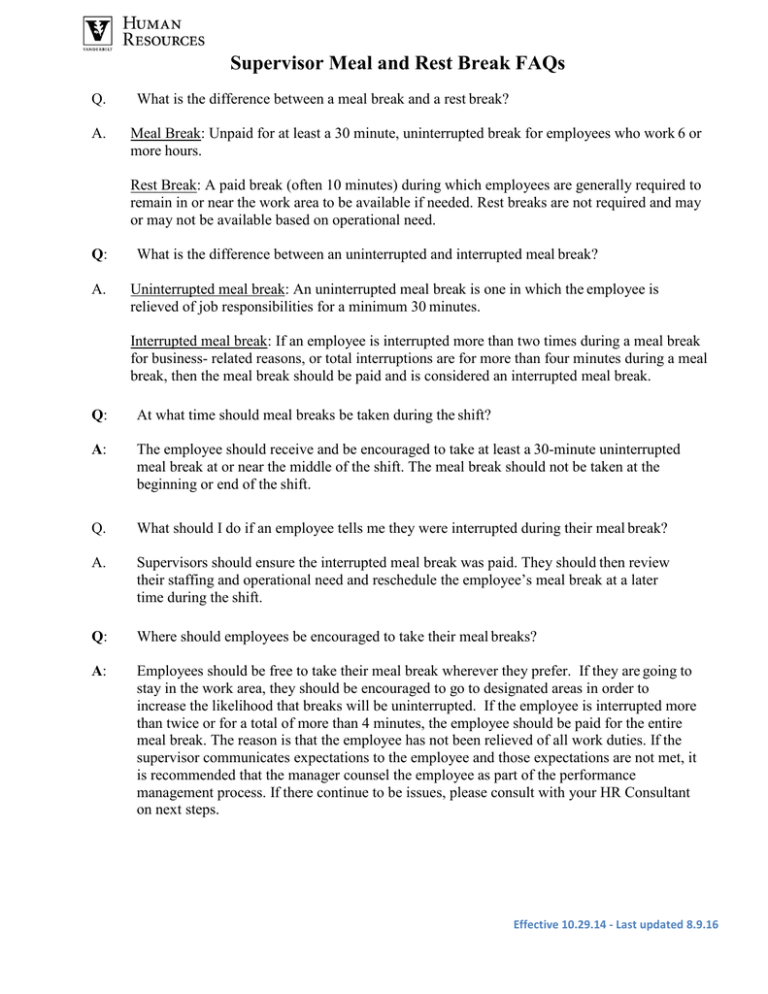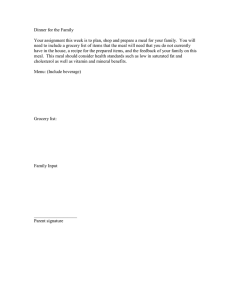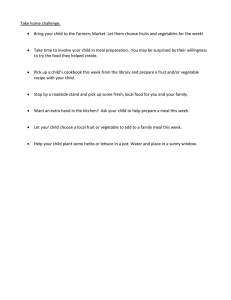Supervisor Meal and Rest Break FAQs
advertisement

Supervisor Meal and Rest Break FAQs Q. A. What is the difference between a meal break and a rest break? Meal Break: Unpaid for at least a 30 minute, uninterrupted break for employees who work 6 or more hours. Rest Break: A paid break (often 10 minutes) during which employees are generally required to remain in or near the work area to be available if needed. Rest breaks are not required and may or may not be available based on operational need. Q: A. What is the difference between an uninterrupted and interrupted meal break? Uninterrupted meal break: An uninterrupted meal break is one in which the employee is relieved of job responsibilities for a minimum 30 minutes. Interrupted meal break: If an employee is interrupted more than two times during a meal break for business- related reasons, or total interruptions are for more than four minutes during a meal break, then the meal break should be paid and is considered an interrupted meal break. Q: At what time should meal breaks be taken during the shift? A: The employee should receive and be encouraged to take at least a 30-minute uninterrupted meal break at or near the middle of the shift. The meal break should not be taken at the beginning or end of the shift. Q. What should I do if an employee tells me they were interrupted during their meal break? A. Supervisors should ensure the interrupted meal break was paid. They should then review their staffing and operational need and reschedule the employee’s meal break at a later time during the shift. Q: Where should employees be encouraged to take their meal breaks? A: Employees should be free to take their meal break wherever they prefer. If they are going to stay in the work area, they should be encouraged to go to designated areas in order to increase the likelihood that breaks will be uninterrupted. If the employee is interrupted more than twice or for a total of more than 4 minutes, the employee should be paid for the entire meal break. The reason is that the employee has not been relieved of all work duties. If the supervisor communicates expectations to the employee and those expectations are not met, it is recommended that the manager counsel the employee as part of the performance management process. If there continue to be issues, please consult with your HR Consultant on next steps. Effective 10.29.14 - Last updated 8.9.16 Q: What if an employee wishes to take their meal break at their desk? A: The best practice is to have employees take meal/rest breaks somewhere other than their desk or work area. If an employee remains at her/his desk during a meal break, the use of signage is recommended so that others in the work unit are on notice that the employee is taking a meal break and should generally not be interrupted for a work-related reason in order to facilitate an uninterrupted break. If the supervisor communicates expectations to the employee and those expectations are not met, your HR Consultant should be contacted regarding next steps. Q. Are smoking breaks given in addition to meal or rest breaks? A. No. Smoking breaks are included in meal or rest breaks. Q: Can employees do whatever they want on meal or rest breaks, i.e., go for a walk, go off campus, take a nap, do personal work, or stay at their desk? A: Meal breaks: It is up to employees to decide how to use their meal breaks. The supervisor should schedule the meal breaks in coordination with the operational needs of the work unit. Meal breaks should occur at a scheduled time, typically mid-shift or within a specified period of the work shift, which is suitable for a normal meal break. As long as employees are relieved of work- related responsibilities for 30 minutes of uninterrupted time, they may do whatever they want during that time. In other words, employees may choose to eat or to use the time for other personal purposes, which may include walking, reading, etc. Rest breaks: The staff member needs to be available to return to the work area quickly, should an urgent need arise. Q: What do I do about meal or rest breaks if I only have one employee? A: Determining operational needs and service expectations and how to accommodate them in scheduling meal breaks is a question that is best answered by the manager of the area. You may want to consider some type of float pool or relief for the employee so they can take their meal break. If the employee does not have a chance to take a meal break, she/he would be paid for the entire meal break. This should be the exception, not a frequent practice. Q: How is timekeeping handled for potlucks, celebratory lunches, and departmental inservices with lunch? A: Departmental lunches may be considered as work time if attendance is required or expected for all employees and/or they are engaged in work-related activities. It does not matter whether or not the lunch is onsite or offsite. In instances where the work unit has a lunch (e.g., supervisor invites employees and they feel they have to attend) and attendance is Effective 10.29.14 - Last updated 8.9.16 required or work is being performed, these lunches would not be considered an uninterrupted meal break and would be paid time. Otherwise, if the attendance is voluntary and there is no work being performed nor are there any work interruptions, this would be considered an uninterrupted meal break. Q: How do you handle employees who want to work through meal breaks so they can leave early or come in late? A: This is inconsistent with Vanderbilt policy and the intent of the meal break. The employee should receive and be encouraged to take a 30-minute uninterrupted meal break mid-shift. The meal break should not be taken at the beginning or end of the shift. As managers, it should not be a common practice to allow employees to leave early if they have not taken their meal break. From time to time, there may be a rare occasion when an employee requests to work through their meal break and leave early. Please use your best judgment in these scenarios consistent with staffing needs. Also, this should be the exception, not the rule. Remember that employees are expected to take a meal break and should not repeatedly skip meal breaks in order to shorten their scheduled work hours. Q: What do I do if an employee chooses not to take a meal break? A: The supervisor’s responsibility is to schedule every employee who works 6 hours or more for at least a 30 minute uninterrupted meal break, preferably away from the work area. This can best occur through setting and communicating expectations and then monitoring practice to ensure expectations are being met. If the supervisor communicates expectations to the employee and those expectations are not met, it is recommended that the supervisor counsel the employee as part of the performance management process. If there continues to be issues, please consult with your HR Consultant on next steps. In certain circumstances, an employee who has worked through lunch may also be entitled to overtime, if working through a meal break causes the employee to work more than 40 hours a week. Q: Do employees carrying a pager need to answer it during lunch? A: The expectation is that the meal break is to be uninterrupted for at least 30 minutes. While this is the expectation, we realize that this may not always be possible. Additionally, it may not be possible or appropriate in all instances to physically remove beepers and phones from employees. Typically, if an employee has possession of a pager, it would not make a meal break compensable. The issue is whether the meal break becomes interrupted when employees are paged and respond to that page. A meal break becomes an interrupted meal when an employee is interrupted more than twice or for a total of more than 4 minutes during a 30minute meal break. Accordingly, the possession of a pager may convert a meal break to compensable work time depending on the nature of any pages (e.g., is an immediate response required, does the employee need to report to the work area, how much time is needed to respond) and the frequency/number of pages received during the meal break. An option would be to have the employee answer the page and explain that they will call back after their meal break as long as they remain within the definition of uninterrupted. Your leadership team may want to review the culture and expectations for providing pager coverage to ensure that employees receive an uninterrupted meal break. Effective 10.29.14 - Last updated 8.9.16 Q: How do supervisors ensure that employees are accurately reporting worked time? A: It is the supervisor’s responsibility to review time records frequently, create the environment for employees who work 6 hours or more to get at least a 30-minute uninterrupted meal break, and make sure interrupted meal breaks are reported as paid time. If hours worked exceed 40 in a workweek, they must be reported and paid at the overtime rate. The leader must define a staffing model and schedule that meets both policy and service level needs. It is the responsibility of the employee to report worked time accurately and to approve their own time. If the supervisor communicates expectations to the employee and those expectations are not met, it is recommended that the manager counsel as part of the performance management process. If there continue to be issues, please consult with your HR Consultant on next steps. Q: What flexibility do supervisors have in scheduling meal or rest breaks? A: Meal Breaks: Managers should set and communicate expectations to employees based on operational needs, and meal breaks should be scheduled consistent with those needs. The meal break should typically be taken in or near the middle of the shift, not at the beginning or end of the shift. Rest Breaks: Conversations need to occur with employees to set expectations of when rest breaks and meal breaks are to occur. Rest breaks are not required and may or may not be available based on operational need. Q: How are meal breaks scheduled for employees that travel between work locations? A: If employees work at least 6 hours, they should receive a 30-minute uninterrupted meal break. Eating lunch while driving from one work location to another does not constitute a meal break. An individual would need to be able to have a 30-minute uninterrupted break either before leaving the first location, after arriving at the second location, or by stopping along the way. Effective 10.29.14 - Last updated 8.9.16



